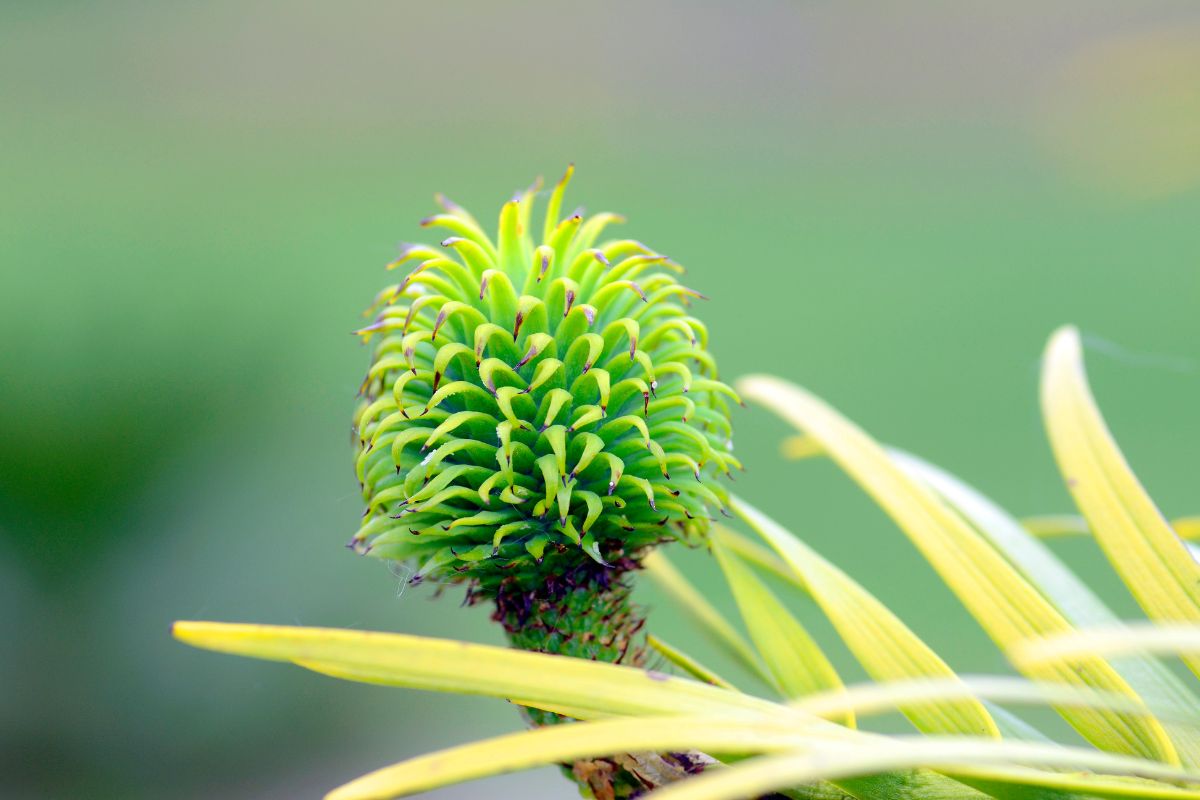Show table of content Hide table of content
In a remarkable botanical breakthrough, a Wollemi pine, a tree species dating back to the dinosaur era, has produced fruits for the first time in the garden of British retirees Pamela and Alistair Thompson. This extraordinary event marks a significant milestone in the conservation efforts for this ancient species, once thought to be extinct for millions of years.
Prehistoric pine bears fruit in English garden
The Wollemi pine, a living fossil approximately 90 million years old, has achieved something unprecedented in the Thompson’s garden in Wichenford, England. The couple purchased the rare conifer at a charity auction in 2010, little knowing they would become part of botanical history.
“We were told it was like adopting a dinosaur,” recalls 75-year-old Pamela Thompson. Their dedication to nurturing this prehistoric specimen has paid off spectacularly, as their tree has produced both male and female cones simultaneously – the essential condition for natural reproduction.
The significance of this event cannot be overstated. Until now, these ancient trees had never been known to reproduce naturally outside their native Australia. Experts from Kew Gardens have expressed amazement at this development, which could potentially revolutionize conservation efforts for the species.
The Wollemi pine’s story mirrors other remarkable discoveries that expand our understanding of life and history. Scientists continue to make breakthrough findings, such as when essential elements for life were detected by James Webb on four exoplanets, demonstrating how discoveries can happen in the most unexpected circumstances.
The remarkable story of the dinosaur-era survivor
The Wollemi pine stands as one of botany’s most astonishing stories. Considered extinct since the Cretaceous period, the species was dramatically rediscovered in 1994 by park ranger David Noble in a remote canyon within Australia’s Wollemi National Park. The discovery sent shockwaves through the scientific community, comparable to finding a living dinosaur.
The tree’s distinctive appearance makes it immediately recognizable. With a spongy bark resembling chocolate dessert, spiral-arranged flexible leaves, and the potential to grow up to 40 meters tall, it represents a genuine portal to prehistoric times. The species survived in complete isolation, with fewer than 100 specimens existing in the wild.
Science This strange red lake in Tanzania turns animals to ‘stone’.
Australian authorities have kept the exact location of these wild specimens confidential to protect them from contamination and disturbance. During the devastating bushfires of 2020, helicopters were deployed specifically to douse these ancient giants, highlighting their irreplaceable value to global biodiversity.
Throughout history, humans have sought to preserve remarkable artifacts and species. Just as researchers have deciphered hidden messages in 19th-century dresses, botanists are now uncovering the secrets of the Wollemi pine’s survival and reproduction.
Why this fruiting event represents a scientific breakthrough
The appearance of fertile cones on the Thompson’s Wollemi pine represents a potential game-changer for the species’ survival. Prior to this event, conservation efforts relied entirely on clonal propagation – essentially creating genetic copies of existing trees. While this technique preserved the species, it created a population with minimal genetic diversity, leaving them vulnerable to diseases and environmental changes.
Sexual reproduction introduces genetic variation, the cornerstone of evolutionary adaptation. If the seeds from the Thompson’s tree successfully germinate, they will produce saplings with unique genetic combinations, potentially strengthening the species’ resilience against future threats.
“If these seeds prove viable, it would represent nothing short of a renaissance for the species,” explains a botanist from Kew Gardens. “Every seed represents a potential new genetic line.”
Alistair Thompson, a former surgeon, compares the waiting process to “expecting panda babies” – rare, precious, and with uncertain outcomes. The couple plans to share any viable seeds with botanical gardens worldwide, creating a distributed network of genetically diverse specimens.
The quest to preserve Earth’s remarkable biodiversity parallels humanity’s other grand endeavors. Scientists have even sent legendary music into space to communicate with extraterrestrials, demonstrating our desire to share and preserve what makes our world unique.
The future of prehistoric pines in modern gardens
On May 4, 2025, the Thompsons will open their garden to the public, offering a rare opportunity to witness this botanical miracle firsthand. This event could spark widespread interest in private cultivation of Wollemi pines, potentially creating a global safety net for the species outside its native habitat.
Science 50 years later, a quantum mystery has finally been solved.
However, growing these prehistoric trees requires specific conditions. They need well-drained soil, filtered light, and protection from severe frost. “This isn’t like growing roses,” cautions Alistair Thompson. “It’s a commitment to a living piece of Earth’s history.”
The story of the Thompsons and their fruiting Wollemi pine demonstrates that conservation heroes don’t always wear lab coats or work in scientific institutions. Sometimes, they’re retirees checking on their garden “in pajamas, like kids on Christmas morning,” as Pamela Thompson describes their daily ritual of monitoring the developing cones.
For those inspired to grow their own piece of prehistory, Wollemi pines are occasionally available through specialized nurseries and botanical gardens. While challenging to maintain, they represent a tangible connection to a world that existed millions of years before humans walked the Earth – a living link to the age of dinosaurs, now writing a new chapter in an English garden.



Nonsense!
I purchased on of these trees as a sprout from National Geographic back in the early 2000s. grew it for 15 yrs before donating it to the arboretum at the University of Davis (California) .
it had been bearing cones for several years.
So they aren’t the first!
No one gives af, this aint the glen larned show…….goofy ass